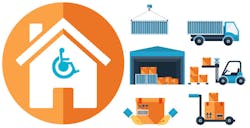In the outpatient arena, the patient’s home remains the final frontier within the care continuum, even if the patient must be checked into a hospice. But how prepared are providers and suppliers to meet demand for services and supplies within a patient’s home, which can be the farthest away from a hospital storeroom or IDN warehouse? Supply chain experts offer mixed, albeit hopeful observations, along with recommendations on what it will take for the industry to improve service.
Healthcare Purchasing News asked supply chain experts to rank provider and supplier preparedness to handle home health supply and service needs on a scale of 1-5 (with one being the least prepared and 5 being the most prepared). Here are their assessments.
Bethann Maynard, Director, Customer Management,
McKesson Medical-Surgical
“Many of our health systems outsource or partner with companies outside of their supply chain to provide patient home care products.
“On a scale from 1-5, the team has estimated a ranking of 4 on preparedness level to meet the demand for service and supplies within a patient’s home. McKesson has the distribution means and the product availability and depth to accommodate a physician’s product needs for a patient.
“Home care is less costly to provide than traditional care in skilled nursing facilities or acute care. This combination of better patient care and lower costs has led many health systems to invest in home care businesses.
“Patients receive next-day delivery in discreet packaging, so they can quickly get what they need, avoiding exposure of sensitive medical information during delivery. Items ship in low units of measure for a single patient’s use, avoiding unnecessary waste and spend.
“Managing these quick deliveries for many patients at home can strain delivery resources. But aligning (or teaming up) with McKesson and our proven expertise in home health can:
Serve patients more quickly, with orders typically delivered the next day
Save nursing and supply chain staff time
Offer clinician trunk stock program to assist with late evening and weekend admitted patients
Reduce shipping, inventory and warehouse space
Eliminate related costs like spoilage, fuel, insurance and fleet maintenance
Decrease additional labor costs in shipping and receiving”
Jared Mohrmann, Senior Director, Supply Chain Operations, Vizient
Provider preparedness rank: 3
“When we talk about supplies, responsibility falls on both providers and suppliers. Often, it all comes down to logistics. When we are addressing shortages and backorders, the non-acute facilities will often be the ones who are left out. The large health systems have the buying power and utilization that demands the focus of national distributors. Non-acute facilities must plan ahead with backup strategies. In shortage or backorder situations.
“What is the second option? What is the third option? These options must be clearly thought out and established procedurally. I don’t think that these plans are in place for many non-acute facilities. For business-as-usual, providers are well prepared to manage the random issues, but, in the event of a natural disaster or extreme shortage, I am concerned that they haven’t done the scenario planning that is necessary to maintain their supply chains. If alternative product solutions have not been predetermined, an organization can be at risk for a supply availability issue, or, in a worst case scenario, be at risk for their ability to administer appropriate patient care.
Supplier preparedness rank, explanation: 3
“National distributors are being challenged in the non-acute space due to the widespread use of just-in-time solutions to service the acute care space. When shortages and backorders from manufacturers happen, everyone is scrambling, and they don’t have a process to quickly ramp up their warehouses to meet the demand. These situations are what is drawing new competitors into the industry, especially in the non-acute market, which continues to expand.”
Brad Clark, General Manager, Strategic Accounts – East U.S., Henry Schein Medical
“Like self-distribution models, home health models vary greatly so the answers truly are customer specific by regions. Home health can be a more expensive model to provide supplies in a timely manner due to several factors, including but not limited to regulatory and HIPAA requirements, fraudulent activities, and delivery locations. Additionally, the billing side of home health, and those who administer or business operations, are key considerations. From a supply chain perspective, we serve several home health agencies and a few hospice networks. I anticipate this market only growing as we expand our capabilities and solutions.”
Byron Zelin, Senior Director, Enterprise Solutions, Intalere
On a scale of 1-5, I would give the current suppliers an overall rating of 3, but working diligently to service this growing part of the market. Many suppliers have more recently stepped up and built specific models around these organizations that really help reduce costs and improve clinical efficiencies. Many home health and hospice organizations are the first to feel product shortages simply due to their size. The demand for care is growing but is challenged in the home setting at times due to possible product shortages or pricing.
“An area of improvement around this market is pricing. There can be a major price discrepancy between acute and home health pricing. This creates a problem with CMS reimbursement for home health and hospice, which has remained relatively flat versus the acute providers. In some cases, you have home health and hospice organizations paying quite a bit more for the same product and getting reimbursed substantially less. This cost and payment model will not be sustainable unless the supplier market becomes more competitive for this sector of the market.”
About the Author
Rick Dana Barlow
Senior Editor
Rick Dana Barlow is Senior Editor for Healthcare Purchasing News, an Endeavor Business Media publication. He can be reached at [email protected].





